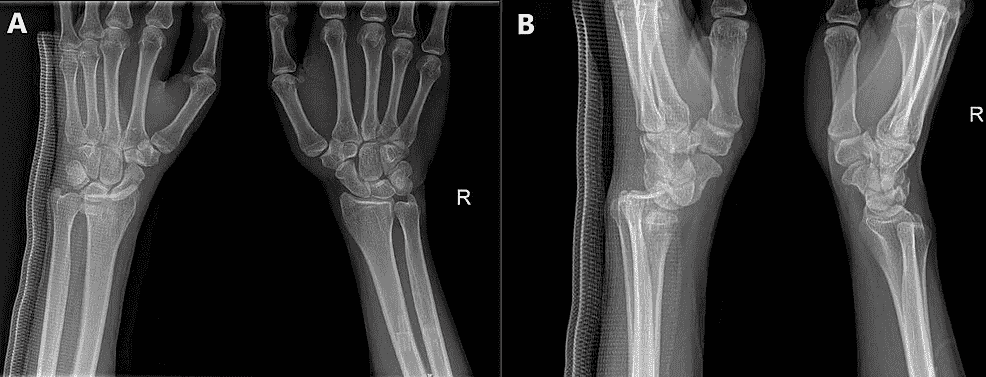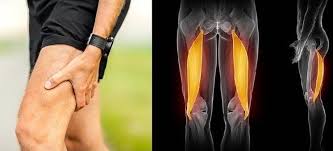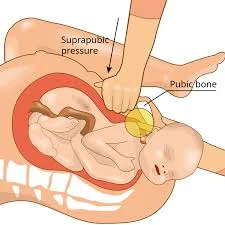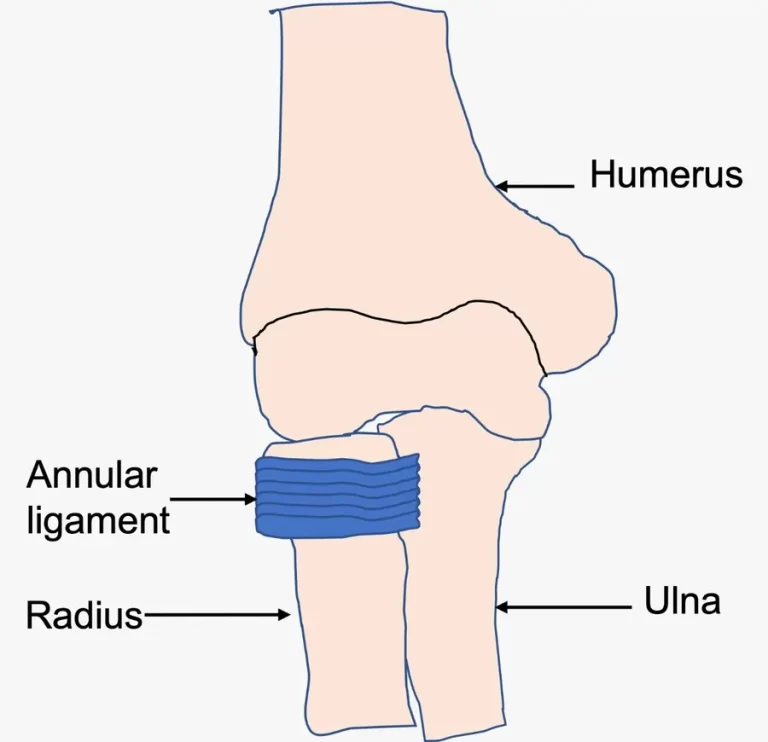Wrist Dislocation
Introduction
A wrist dislocation is one type of ligament injury that can produce unbearable pain. It happens when one or more of the carpal’s small bones in the wrist move out of place from their usual position. Wrist dislocation can be incredibly painful and significantly disrupt your daily life.
It happens when one or more carpal bones in your wrist become misaligned from their natural position. This is typically caused by a tear in the ligaments that hold them together. These dislocations commonly impact the lunate and scaphoid bones, as well as the radius and ulna bones in your forearm. You can learn about the signs, causes, diagnosis, and treatments of a dislocated wrist from this article.
Anatomy
The articulation between the hand’s radius and carpal bones is called the wrist joint, or radiocarpal joint. The synovial joint that suggests the transition from the forearm to the hand is of the condyloid type.
Structure
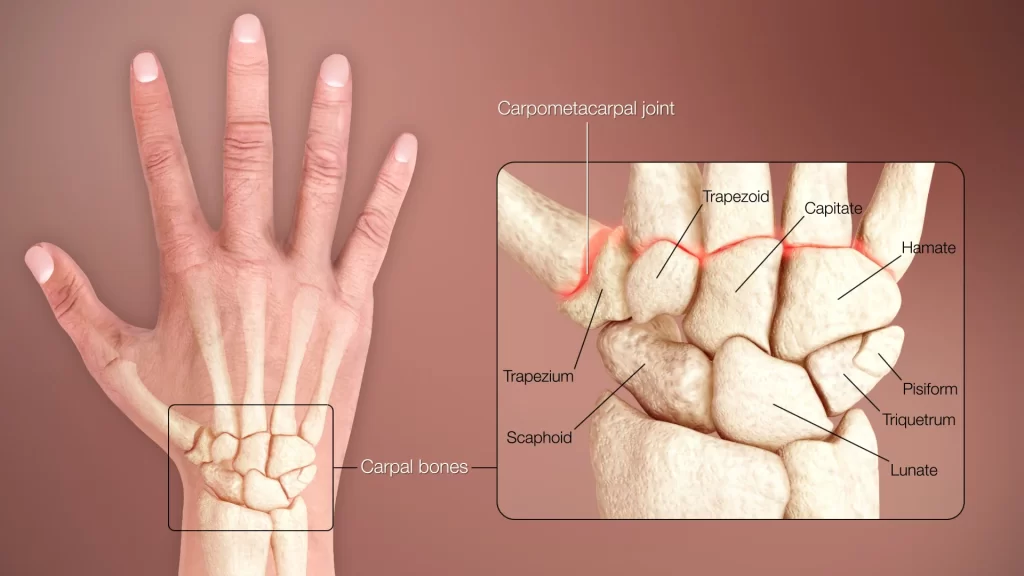
The articulation that forms the wrist joint is between:
- The articular disk and the distal end of the radius.
- The carpal bones’ proximal row, excluding the pisiform.
The convex surface of the carpal bones fits into the concave shape of the articular disk and radius when combined. The articular disk, a fibrocartilaginous ligament, keeps the ulna from articulating with the carpal bones. Rather, the distal radioulnar joint is where the ulna and radius articulate, close to the wrist.
Ligaments
Four primary ligaments surround the wrist joint. The ulnar and radial collateral ligaments, along with the palmar and dorsal radiocarpal ligaments, are the four ligaments in charge of preserving the joint’s stability.
Blood Supply
Your wrists are supplied with blood by two arteries. Your radius, the area proximal to your thumb, is where the radial artery runs. Your ulna, or the part proximal to your pinkie finger, is where the ulnar artery runs.
The nerve supply
Three nerve branches supply sensation to the wrist:
- The anterior interosseous branch (medial nerve).
- The radial nerve’s posterior interosseous branch.
- Dorsal and deep branches of the ulnar nerve.
Muscles and their Function
The wrist is a synovial joint that may move in two directions mainly because it is ellipsoidal (condyloid). This indicates that the wrist joint can be used for flexion, extension, adduction, and abduction. The forearm muscles are responsible for every wrist movement.
The function of these muscles can be categorized into two groups:
Flexors: These muscles enable you to turn your wrists downward and in the direction of your palm. Among them are:
- Flexor Carpi Radialis
- Flexor carpi ulnaris
- Flexor digitorum superficialis.
- Flexor digitorum profundus.
- Flexor pollicis longus.
- Palmaris longus
Extensors: These muscles allow you to bend your wrist up and away from your palm. They include:
- Extensor carpi radialis longus
- Extensor carpi radialis brevis
- Extensor carpi ulnaris
- Extensor digitorum
- Extensor indicis
What is Wrist Dislocation?
The eight little bones in your wrist are known as carpals. They can move and are held in place by an elastic network of ligaments. Two or more of your carpal bones may be forced out of their natural position if one of these ligaments tears. This leads to wrist dislocation.
All eight carpals may be involved in a dislocated wrist, however the scaphoid and lunate bones are frequently impacted. The radius and ulna bones of your forearm, as well as the other, smaller wrist bones, are connected by these two bones.
Types of the Wrist Dislocation
There are several types of wrist dislocations. They include:
- Anterior lunate dislocation. The lunate bone rotates, whereas the other wrist bones remain stationary.
- Perilunate dislocation. This type includes the lunate bone and the three ligaments that surround it.
- Galeazzi fractures. This form includes a break in the radius bone and dislocation of the radioulnar joint.
- Monteggia fracture. This causes a break in your ulna, as well as a dislocation of one of your radius, ends.
Causes of the Wrist Dislocation
A dislocated wrist can occur from any form of acute damage to the hand or arm. Typical reasons for these wounds include:
- High-impact sports, including hockey or football: Dislocated wrists are frequently caused by injuries sustained while playing high-impact sports like hockey or football. These sports involve sudden force that can abnormally twist your hand and arm, dislocating your wrist joint. But contact sports are not the only activities that can result in this kind of injury; gymnastics and cheerleading, for example, entail acts and movements that can call for precise balance and coordination, making them more prone to dislocations.
- Car crashes: Car crashes are a major contributing factor to dislocations. Any kind of collision, whether you are the driver or a passenger, has the potential to apply enough force to your arm or hand to cause the ligaments surrounding your wrist joint to extend beyond their usual range, which could result in bone displacement.
- Using your hand to break a fall: Many individuals break falls with their hands without thinking about it, but if you use too much force, this kind of motion raises the danger of dislocating your wrists.
- Repetitive Motions: Constant pressure on the wrist can cause repetitive strain on the ligaments, which can potentially result in dislocations. When using tools like power tools, repetitive actions are typically the source of this form of injury
- Genetics and degenerative joint conditions like arthritis are other reasons.
- A dislocated wrist can also occur from strain on the wrist ligaments. This degree of strain is typically caused by activities like crutch walking that continuously strain the wrist.
Symptoms of the Wrist Dislocation
Severe discomfort is the main indicator of a dislocated wrist, and it usually gets worse as you try to move your wrist up and down or side to side. Additionally, you may get forearm soreness.
You might additionally see a few things surrounding your wrist:
- Swelling
- Tenderness
- Weakness
- Bruises or discolorations
Your wrist nerves may be compressed if your lunate bone is affected. Your fingertips may get tingly or numb as a result of this.
Risk factors for Wrist Dislocation
Wrist Dislocation is at risk for:
- Engaging in high-impact, severe sports like hockey and football can increase a person’s risk of dislocating their elbow.
- Dislocations of the elbows are more common in sports like volleyball, gymnastics, and downhill skiing because they involve falls.
- Some people are more prone to injure ligaments and joints from birth.
- Patients who are more likely to fall, such as the elderly, are more likely to have dislocations of the elbows.
Diagnosis of the Wrist Dislocation
- Make an appointment with your doctor right away if you believe you have a wrist injury, or go to urgent care to prevent aggravating the problem.
- First, your physician will manipulate your wrist in various postures while inquiring as to whether you are in any pain. They can use this to determine which bones and ligaments may be affected. Any harm done to the tendons, blood vessels, and nerves supplying the hand and wrist will be evaluated by your physician.
- They will most likely conduct an X-ray of your hand and forearm to confirm the diagnosis.
- An MRI may also be used by your doctor to help in the diagnosis if they believe you have a ligament injury. Your soft tissue, including your ligaments, is more clearly seen thanks to this imaging test.
Treatment of the Wrist Dislocation
Conservative treatment
- For modest dislocations, a reduction procedure is typically performed. During this process, your physician carefully realigns the bones to their original locations. The degree of pain you experience depends on the extent of your injury. Your doctor will administer either local or general anesthesia in advance to aid with the pain.
- Required to wear a splint after the treatment to keep your wrist immobile. You may also require the use of a sling.
Surgical Treatment
- In more extreme situations, surgery may be required to straighten the bones in your wrists or to heal torn ligaments. Sometimes screws or pins are used for this to keep everything in place.
What is the duration of healing?
- The degree of the dislocation determines how long it takes for the wrist to heal. You should heal in two to three months if you just require a reduction surgery. It can take six months to a year to fully recuperate, though, if surgery is necessary.
- To restore strength and flexibility to your wrist, physical therapy will be necessary after receiving any kind of treatment. While you heal, it could be necessary for you to visit a physical therapist or complete mild exercises by yourself.
- Try not to put any strain on your wrist as much as you can as you heal.
Physical therapy for Wrist Dislocations
Physical therapy is vital in the rehabilitation process after a wrist dislocation.
- Modalities: Ice, heat, and electrical stimulation can all help to relieve pain and inflammation.
- Splinting: Making use of a splint might help the wrist heal by immobilizing it.
- Increase range of motion: Gentle workouts will help you regain flexibility and avoid stiffness.
- Strengthening exercises: These involve using resistance bands or weights to increase wrist and forearm strength.
- Functional training: Activities that replicate daily chores can help you regain normal wrist function.
Summary
A wrist injury can significantly affect your daily life. This is why it is critical to get prompt care for any wrist injury. Depending on whether you need surgery, your recovery time will range from two months to a year. Even after you’ve recovered, you may need to wear a wrist brace when performing tasks that place a lot of strain on your wrist, such as heavy lifting.
FAQs
What are the different types of wrist dislocation?
Scapholunate dissociation, lunate dislocation, and perilunate dislocation are the three most frequently occurring wrist dislocations.
What causes the wrist to dislocate?
The lunate or capitate, the carpal bones at the base of the hand, shift from their natural position. When the wrist is bent backward and significant force is applied, these dislocations typically happen. People can’t move their hands and wrists normally, and they hurt and may appear malformed.
How is a dislocated wrist fixed?
When a patient has a dislocated wrist, medical professionals move the wrist bones back into position without cutting (a procedure known as closed reduction). The elbow and wrist are then stabilized with the application of a splint. Doctors typically also recommend orthopedists right away to patients.
Which wrist bone dislocations occur most frequently?
A fall into an extended hand is what induced this injury. The lunate bone of the proximal row of carpal bones as well as other bones are involved in most wrist dislocations.
How much time does it take for a wrist dislocation to heal?
Depending on the extent of the damage, a dislocated wrist might heal over a wide range of times. If surgery is necessary, full recuperation may take up to a year. In milder cases, reduction treatments might be sufficient, and you should see a difference in two or three months
What differentiates a dislocation from a sprain?
Fracture and “broken bone” have identical interpretations. Different types of fractures exist. Sprains are caused by tearing and stretching of the ligaments that hold joints together. When the bones split at the joint, it is called a dislocation.
References
- Hand, Wrist, or Elbow Dislocations. (n.d.). https://www.mercy.com/health-care-services/orthopedics-sports-medicine-spine/specialties/hand-wrist-elbow/conditions/hand-wrist-elbow-dislocations
- Cast. (2023, November 28). Wrist Dislocations: Types, Symptoms, and Treatment Options. https://www.cast21.com/blog/dislocated-wrist
- Roland, J. (2018, May 3). Everything You Need to Know About Dislocated Wrists. Healthline. https://www.healthline.com/health/dislocated-wrist#healing-time
- Halimi, K. M. (n.d.). Wrist Dislocation in Sports Medicine: Practice Essentials, Etiology, Epidemiology. https://emedicine.medscape.com/article/98552-overview?form=fpf
- Germann, C. A., & Perron, A. D. (2010). Risk Management and Avoiding Legal Pitfalls in the Emergency Treatment of High-Risk Orthopedic Injuries. Emergency Medicine Clinics of North America, 28(4), 969–996. https://doi.org/10.1016/j.emc.2010.06.002

